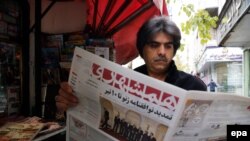Two of Iran’s largest-circulation dailies have cut back on pages due to paper scarcity, amid U.S. sanctions and economic crisis.
Amid a "paper crisis," state-run dailies Iran and Hamshahri have reduced by eight pages, saying their newspapers will be published with only 16 pages until further notice.
Hamshahri (Fellow Citizen), founded in 1992 and published by the municipality of Tehran, is the first color daily newspaper in Iran and used to have over 60 pages of classifieds. The journal is distributed within the limits of Tehran municipality. Reportedly, Hamshari's circulation in Tehran is nearly 180,000.
In the Iranian new year (which began March 21) paper has gone from being expensive and scarce to "nonexistent," Hamshahri announced on its Twitter account.
Meanwhile, Iran's editor-in-chief, Javad Delbari, revealed another aspect of the paper scarcity in a tweet, admitting that Iranian dailies will be out of paper within one or two days.
Daily Iran was launched in 1995 and is owned by the government's official news agency (IRNA) and sells 110,000 copies a day.
"Paper scarcity is so tight that many dailies have lost two-thirds of their circulation in the last two months," Delbari said.
Other reports also confirm that the price of paper has skyrocketed to the extent that not only newsprint paper but all different types have practically become nonexistent.
The price of paper in the past year has increased up to 340 percent, while it is a commodity bought and imported by governmental subsidies. While Iran's currency has sunk to as low as 155,000 rials to the dollar on the open market, the government provides much cheaper foreign currency for essential imports, at 42,000 rials to the dollar.
The Iranian authorities have repeatedly reported paper merchants violating the law and caching imported paper for more profit.
Tehran police chief and Islamic Revolutionary Guards Corps (IRGC) Brigadier General Hossein Rahimi recently said a wholesaler dubbed the "Sultan of Paper" had been arrested.
"The Sultan of Paper, along with 16 others, has imported 30,000 tons of paper with subsidized currencies, but sold it in the open market," Rahimi said. "The detainee is accused of pocketing 17 trillion rials (about $110 million based on open market rate)."
Based on local news reports, more than 90 percent of the Iranian publishing industry’s paper is imported.
Apparently, the current paper crisis in Iran is not unprecedented. Culture and Islamic Guidance Minister Abbas Salehi said on April 4 that the country has just enough newsprint paper in storage to meet two months worth of demand. In response to the shortage, some newspapers have been forced to cease publishing, while others, including the popular reformist newspaper Shargh, have put up a paywall.
Mahmoud Sadri, a veteran journalist, sees the paper crisis as just the latest manifestation of "Iran's economic inefficiency." Speaking to Bourse & Bazaar, Sadri explained, "We have no phenomenon called a paper crisis as a separate and standalone phenomenon. It's not accurate to just say paper is in crisis since many goods are in crisis."
The volume and price of paper imported to Iran in 2018 almost doubled compared with the previous year, more than 800 million tons and $700 million, respectively.







